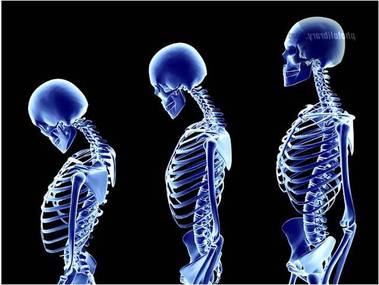
So why focus on posture?
Scientific research has shown that posture is an important health indicator. Poor structural alignment has been associated with various disorders including pain syndromes(2-4), a whole range of musculoskeletal disorders(5) and breathing disorders(7). In addition, postural abnormalities in the elderly have been associated with poor balance and
a higher risk of falls(8-10).
An article from the Journal of American of Pain Management(7) states that:
“Spinal pain, headache, mood,
blood pressure, pulse, and lung
capacity are among the functions
most easily influenced by posture.”
Perhaps the most common posture abnormality is Forward Head Posture (FHP). FHP leads to muscle strain, disc herniations, arthritis and pinched nerves(6). There is now clear evidence of increased pain and decreased body function as the severity of FHP increases(12). The severity of these symptoms increases in a linear fashion with progressive worsening of FHP.
Poor posture affects everyone from young to old. Studies have been done showing the connection between heavy school bags causing poor posture in kids, which causes reduced lung capacity(13). In addition, research has shown that height loss in older men have a 42% increased risk of heart disease, even in men who have no history of heart disease(14). Another study shows that older men and women with poor posture have higher mortality rates(15).
In summary, poor posture:
a) Causes pain, muscle strain, spinal and disc problems, arthritis(6)
b) Affects almost all major body joints(2-6)
c) Affects dozens of muscles, including all core muscles(3,11)
d) May diminish lung capacity(7)
e) May diminish cardio/heart capacity(14)
f) Decreases range of motion(12)
g) Reduces physical performance(13)
h) Shortens lifespan(15)
How we correct your posture.....Step 3
Scientific research has shown that posture is an important health indicator. Poor structural alignment has been associated with various disorders including pain syndromes(2-4), a whole range of musculoskeletal disorders(5) and breathing disorders(7). In addition, postural abnormalities in the elderly have been associated with poor balance and
a higher risk of falls(8-10).
An article from the Journal of American of Pain Management(7) states that:
“Spinal pain, headache, mood,
blood pressure, pulse, and lung
capacity are among the functions
most easily influenced by posture.”
Perhaps the most common posture abnormality is Forward Head Posture (FHP). FHP leads to muscle strain, disc herniations, arthritis and pinched nerves(6). There is now clear evidence of increased pain and decreased body function as the severity of FHP increases(12). The severity of these symptoms increases in a linear fashion with progressive worsening of FHP.
Poor posture affects everyone from young to old. Studies have been done showing the connection between heavy school bags causing poor posture in kids, which causes reduced lung capacity(13). In addition, research has shown that height loss in older men have a 42% increased risk of heart disease, even in men who have no history of heart disease(14). Another study shows that older men and women with poor posture have higher mortality rates(15).
In summary, poor posture:
a) Causes pain, muscle strain, spinal and disc problems, arthritis(6)
b) Affects almost all major body joints(2-6)
c) Affects dozens of muscles, including all core muscles(3,11)
d) May diminish lung capacity(7)
e) May diminish cardio/heart capacity(14)
f) Decreases range of motion(12)
g) Reduces physical performance(13)
h) Shortens lifespan(15)
How we correct your posture.....Step 3
|
References:
1.McEvoy MP, Grimmer K. Reliability of upright posture measurements in primary school children. BMC Musculoskeletal Disorders. 2005; 29;6:5. 2.Harber P, Bloswick D, et al. Supermarket checker motions and cumulative trauma risk. J Occup Med. 1993; 35:805-11 3.Genaidy AM, Karwowski W. The effects of neutral posture deviations on perceived joint discomfort ratings in sitting and standing postures Ergonomics.1993;36:785-92 4.Rys M, Konz S. Review Standing. Ergonomics. 1994; 37;676-87 5. Tsuji T, Matsuyama Y, et al. Knee-spine syndrome:correlation between sacral inclination and patella-femoral joint pain. J OrthopSci. 2002; 7: 519-23 6. Mayo Clinic Health Letter. March 2000 7. Lennon J, Shealy N, et al. Postural and respiratory modulation of autonomic function, pain and health. Am J Pain Manag.1994; 4: 36-9 8. O’Brien K, Culham E, et al. Balance and skeletal alignment in a group of elderly female fallers and non-fallers. J Gerontol A Biol Sci Med Sci.1997; 52:B221-26 9. Balzini L, Vanucchi L. Clinical characteristics of flexed posture in elderly woman. J Am Geriatr Soc. 2003; 51:1419-26 10. Lynn SG, Sinaki M, et al. Balance characteristics of persons with osteoporosis. Arch Phys Med Rehabil. 1997; 78: 273-77 11.Yip CH, Chiu TT, et al. The relationship between head posture and severity and disability of patients with neck pain. Man Ther. 2008; 13: 148-54 12. Glassman SD, Keith B et al. The Impact of Positive Saggital Balance in Adult Spinal Deformity. Spine. 30(18); 2005; 2024-29 13. Lai JP, Jones AY. The effects of shoulder girdle loading by a school bag on lung volumes in Chinese primary school children. Early hum Dev. 2001; 62(1):79-86 14. Wannameethe SG. Height loss in older man associations with total mortality and incidence of cardiovascular disease. Arch Intern Med 2006; 166: 2546=2552 15. Kado DM, Huang MH, et al. Hyperkyphotic posture predicts mortality in older community dwelling men and women: A prospective study. J Am Geriatr Soc. 2004; 52(10):1662 Image credit: Daniel Kraus, flickr
|

